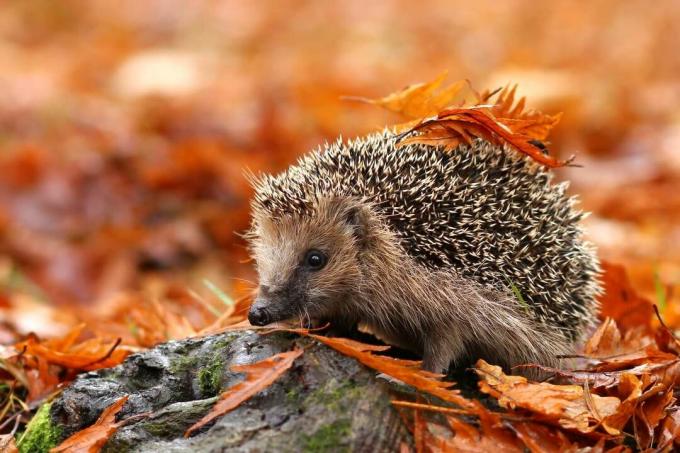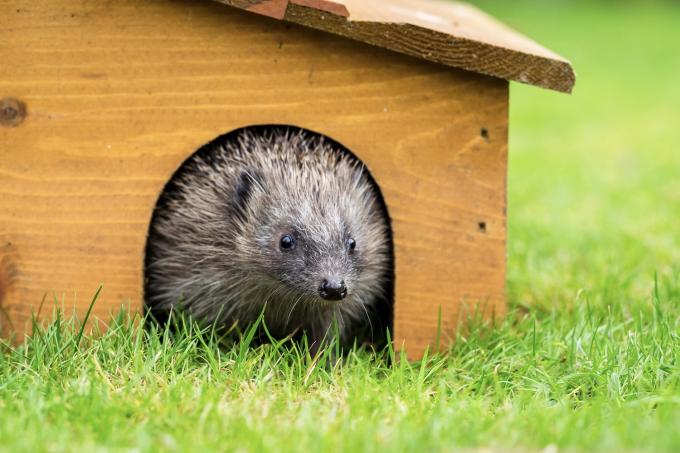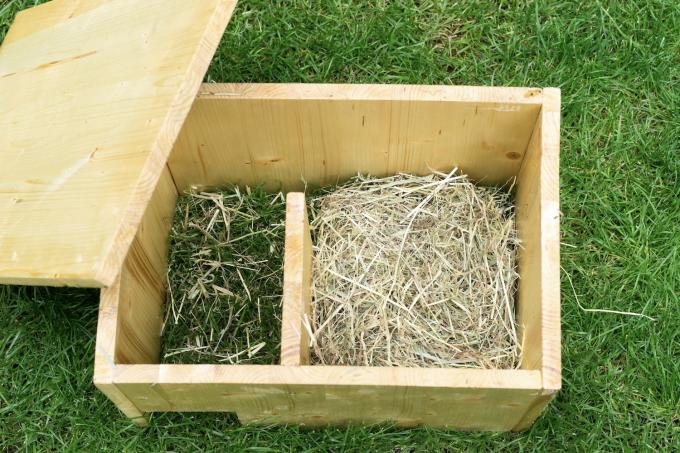You can give hedgehogs a good helping hand in the garden. Here you can find out how to build a hedgehog house and whether you should feed a hedgehog.

Cute face, black beady eyes and sharp spines - hedgehogs are welcome visitors in the garden. But although gardens are one of the hedgehog's most important habitats, the cute animals are increasingly having trouble finding a suitable place. A lack of hiding places, a scarce supply of food and other factors make survival difficult for many hedgehogs. But helping hedgehogs in the garden is not that complicated - you can find out what a hedgehog house is and how best to feed hedgehogs in this article.
contents
- Why should you support hedgehogs in autumn?
-
Prepare the garden for the hedgehog in the fall
- Build hedgehog house as winter quarters
- Should you feed hedgehogs in winter?
- Hedgehog-friendly garden design
Why should you support hedgehogs in autumn?
Hedgehogs not only look interesting and cute, they can also be particularly useful in the garden: slugs and other pests are on the menu for hedgehogs. Garden owners can therefore be particularly happy about a hedgehog in the garden, because the prickly beneficial insect helps in the fight against harmful insects in the garden. At the same time, there is no need to be afraid of hedgehogs causing damage in the garden - since they can his diet relies almost exclusively on animal protein, he neither nibbles nor nibbles on the vegetable patch windfall. The concern that hedgehogs will devastate the garden bed is therefore unfounded. Especially when there are children in the house, the hedgehog fulfills other tasks in the garden: the nice garden dweller is an ideal candidate to arouse children's interest in the garden and nature. Watching the hedgehog in the garden is exciting for the little ones, as is building hedgehog houses or laying out food for the hedgehog often creates enthusiasm and helps children to get a first impression of forest and garden animals obtain. However, when watching the hedgehog, an adult should always be present to ensure that the children do not get too close to the hedgehog. Touches, such as stroking, not only mean stress for the wild hedgehog, but also pose a risk of injury for the child due to the sharp spikes. A safe distance should therefore always be maintained when observing.

Prepare the garden for the hedgehog in the fall
Hedgehogs depend on our support, especially in autumn, because the approaching winter means great deprivation for the little animals. Fortunately, you can help hedgehogs without much effort if you prepare your garden for hedgehogs in the fall.
Build hedgehog house as winter quarters
Fewer and fewer gardens have enough possible winter quarters for hedgehogs to hibernate in. A simple but effective measure to help hedgehogs in winter is therefore to provide a suitable shelter for hedgehogs. In larger gardens, it is advisable to set up a "wild corner" with piles of brushwood, dense bushes and piles of leaves in which the hedgehog can find shelter. Rain and wind-protected locations between bushes or next to walls are particularly suitable.
If you don't have space to create such a corner, you can still build a shelter for the hedgehog: A hedgehog house is an ideal shelter for the small animals and doesn't take up much space.

If you want to build a hedgehog house yourself, you don't even need much:
- Wooden boards 2 cm thick and at least 26 cm wide
- Roof battens or other squared timber
- linseed oil
- jigsaw
- Cordless screwdriver, 3-piece drill
- wood file
- 4 x 35 Countersunk Screws
- paint brush
First, the individual parts for building the hedgehog house are drawn on the boards and then sawn out with a jigsaw. A rear section measuring 40 x 26 cm and a roof measuring 49 x 36 cm are required. In addition, you need two slanted side parts (24 or 26 x 30 cm) and a sloping partition (24 or 25x17cm). Due to the slight incline of the roof, rainwater can run off better later. The front is 40 x 24 cm in plan, but should have a 10 x 10 cm cut-out in one corner as an entrance for the hedgehog.
Dimensions of the components:
- Back panel 40cm x 26cm
- Side panel (2x) 24 or 26cm x 30cm
- partition 24 or 25cm x 17cm
- Roof 49cm x 36cm
- Front 40cm x 24cm with exit 10cm x 10cm
Once the parts have been cut out, all edges should be smoothed with the wooden arrow so that there are no sharp edges on which the hedgehog could injure itself. Now the front, back and side parts are joined together. It is best to pre-drill the holes with a wood drill bit before screwing the parts together. The partition wall is screwed inside the hedgehog house next to the entrance to the front of the house. This crooked entrance area later protects the hedgehog from possible larger predators such as dogs. For the roof, the depth of the interior is measured and two roof battens are shortened accordingly. These are attached to the roof that has been sawn out in such a way that they are aligned with the side walls and front and back sides lock - so the roof can be removed, but does not slip down to the side if something happens gets stormier. Finally, the wood is coated with a non-toxic glaze (such as linseed oil) to make it more weather-resistant.

Summary of building a hedgehog house:
- Saw out components with a jigsaw
- smooth edges
- Connect the front, side and rear panels with screws
- Screw on the partition next to the entrance inside the hedgehog house
- Measure the depth of the interior and shorten two roof battens to length
- Screw the roof battens onto the roof
- Paint the hedgehog house with linseed oil

If you have built your own hedgehog house, you still have to place it correctly. A quiet, undisturbed place that is also protected from the weather is ideal. It has proven itself, for example, to set up the hedgehog house in or under a hedge. Hedgehog houses are particularly well accepted if they are covered with brushwood and leaves. But what do I fill a hedgehog house with? Basically, the hedgehog house should only be filled in the sleeping area and not in the entrance area: hay, ideally of organic quality, is best suited for filling the hedgehog house. The sleeping area can be well padded with hay.

Should you feed hedgehogs in winter?
A big problem that many hedgehogs face in the garden is that they cannot find enough food. Feeding hedgehogs can therefore make sense, especially in early spring, late autumn and in very mild winters with a sudden rise in temperature. Because directly before and after hibernation, but also when waking up early during a warm weather period, the animals have an urgent need to strengthen themselves with some food. It is important to pay attention to suitable and hygienic food. Above all, animal protein, which they ingest in the form of beetles, snails and insects, is essential for the survival of the cute animals. Especially inexperienced young animals often do not find enough food to make ends meet. Animals that do not have a typical pear-shaped shape in autumn, but appear rather elongated or even have sunken flanks are severely malnourished and dependent on human help to survive the winter survive.
Garden owners can easily support the animals by feeding the hedgehogs. Wet cat food is particularly suitable as hedgehog food because, unlike dog food, it has only a low grain content and contains a lot of animal protein. Unseasoned scrambled eggs and special hedgehog food from the animal market can also be fed to hedgehogs without any problems. Milk is also recommended as food for hedgehogs - but this is not suitable for feeding hedgehogs, because the animals cannot digest the lactose (milk sugar) it contains and often have gastrointestinal problems react. Human food leftovers or fresh fruit are also unsuitable for hedgehogs, because hedgehogs are primarily carnivores.

The food is best laid out on a plate in a sheltered spot in the garden. An inverted wooden box with an escape hole for the hedgehog can also protect the food from moisture and other animals such as cats or birds. During the day, the feed should always be checked and leftovers removed if necessary, so that mold does not form.
SummaryFeed hedgehogs:
- Suitable feed for hedgehogs: Wet cat food, hedgehog food, unseasoned scrambled eggs
- Unsuitable food: milk, fruit, leftovers
- Put food in a sheltered place
- Daily control and removal of leftover food
tip: To check whether the food was actually eaten by the hedgehogs in the garden and not for A wildlife camera can be set up at the feeding station to attract rats, cats or maggots will.
Hedgehog-friendly garden design
How can you help hedgehogs? This question is easy to answer: the best protection for hedgehogs is not help in an emergency, but rather creating a hedgehog-friendly garden. A hedgehog-friendly garden should be as natural as possible in order to offer the hedgehogs suitable shelter and feeding opportunities. particularly dense, flowering hedges are a paradise for hedgehogs, because they not only serve as a shelter, but also attract numerous insects, which the hedgehogs use as food.
Hedgehogs, on the other hand, do not like fences because they exclude them from the garden. If you already have a fence in your garden, you can make a 10 x 10 cm hole in the ground - this way the hedgehog can get in, but possible larger enemies such as dogs stay outside. In addition, the hedgehog loves "wild corners" with high grass, piles of leaves and native shrubs. For the hedgehog, on the other hand, water is both a curse and a blessing: the animals are at drinking stations instructed, but hedgehogs also drown in garden ponds again and again because they don't have any enduring water are swimmers. A gentle slope into the garden pond is therefore ideal in a hedgehog-friendly garden - steep Edges, on the other hand, should be mitigated by a sloping board protruding into the water as an exit aid. If you don't have a garden pond, you can put a shallow bowl of water for the hedgehog to drink.

You should also be considerate of hedgehogs when cultivating your garden: use insecticides and insecticides slug pellets have no place in a hedgehog-friendly garden, because they rob the animals of their basic food or even poison them. Another danger point in gardening that is often underestimated is lawn mowing: Lawn mower robots in particular pose an enormous danger for the small animals. They often mow the lawn at dusk or during the night, i.e. at the time when the hedgehog is active. If there is a confrontation, the animals often suffer cuts on the mouth and legs, which can be fatal. It is therefore better to mow the lawn yourself and to watch out for the prickly animals, especially near piles of wood and piles of leaves. With these simple measures you minimize the sources of danger for hedgehogs in the garden and support these useful helpers in the garden.
A hedgehog-friendly garden is characterized above all by the following:
- Natural design with "wild corners"
- Flowering hedges as a border
- Fences with passage for hedgehogs
- Garden pond with gentle slopes or exit aid
- Avoid using insecticides
- No robotic lawn mowers, especially mowing at night
In addition to hedgehogs, are other visitors to your garden important to you? Here's how you can attract and support insects by using a insect friendly garden shape.
On our Instagram page you will find new tips and tricks about sustainable gardening every day, as well as exciting looks behind the scenes at Plantura. Just come and have a look!
planturagarden
For more sustainable plant splendor 🌿
Our products come to you with ❤️ 🏠
Share your plants 📸 under #PlanturaPlants










...and receive concentrated plant knowledge and inspiration directly in your e-mail inbox every Sunday!



